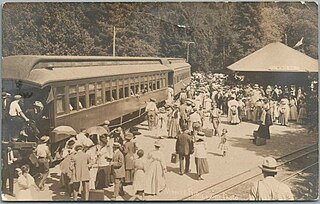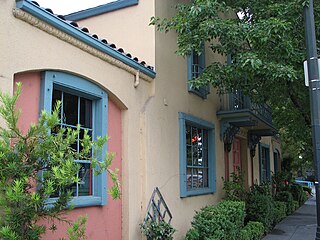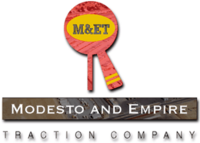
The Northwestern Pacific Railroad is a 271-mile (436 km) mainline railroad from the ferry connections in Sausalito, California north to Eureka with a connection to the national railroad system at Schellville. The railroad has gone through a history of different ownership and operators but has maintained a generic name of reference as The Northwestern Pacific Railroad, despite no longer being officially named that. Currently, only a 62-mile (100 km) stretch of mainline from Larkspur to the Sonoma County Airport in Windsor and east to Schellville on the “south end” is operated by Sonoma–Marin Area Rail Transit (SMART), which operates both commuter and freight trains with plans for future extension north to Cloverdale. The “north end” from Willits to Eureka is currently out of service, but saved by 2018 legislation to be converted into the Great Redwood Trail.

The Almanor Railroad was a Class III short-line railroad operating in Northern California, USA. It was owned by Collins Pine Company, a division of The Collins Companies and annually hauled approximately 300 carloads of timber and lumber products generated at the mill. The railroad was named after Lake Almanor, which the railroad ran over and adjacent to.

The Richmond Pacific Railroad is a terminal railroad owned by the Levin-Richmond Terminal Corporation. The RPRC operates on 2.5 miles (4.0 km) of track in the shipping terminal and wharves at Richmond, California.

The Central California Traction Company is a Class III short-line railroad operating in the northern San Joaquin Valley, in San Joaquin County, California. It is owned jointly by the Union Pacific and BNSF Railway.

The Pacific Harbor Line was formed in 1998 to take over the Harbor Belt Line (HBL). In 1998, the Alameda Corridor was nearing completion, allowing for a massive amount of railroad traffic from the largest harbors in the Western hemisphere: Port of Los Angeles and Port of Long Beach.
The Oakland Terminal Railway was a terminal railroad in West Oakland, California. The OTR was jointly acquired in 1943 by the Western Pacific Railroad and Atchison, Topeka and Santa Fe Railway to take over the Key System's freight railroad known as the Oakland Terminal Railroad. Today, the OTR is now the West Oakland Pacific Railroad that operates on 10 miles (16 km) of track. OTR was jointly owned by the Union Pacific Railroad and BNSF Railway. The railroad operated in the industrial area around the Oakland Army Base.

The Quincy Railroad is a 3.27-mile terminal railroad located at Quincy, California. The QRR interchanges with the Union Pacific at Quincy Junction in Plumas County, California, United States.
The Santa Maria Valley Railroad is a 14.8 miles (23.8 km) shortline railroad that interchanges with the Union Pacific Railroad's Coast Line at Guadalupe, California. As of 2006, the Railroad is owned by the Coast Belle Rail Corporation.
Established in 1908, the Stockton Terminal and Eastern Railroad provides service to several companies around the Stockton area, in San Joaquin County, California.

The Sacramento Northern Railway was a 183-mile (295 km) electric interurban railway that connected Chico in northern California with Oakland via the state capital, Sacramento. In its operation it ran directly on the streets of Oakland, Sacramento, Yuba City, Chico, and Woodland. This involved multiple car trains making sharp turns at street corners and obeying traffic signals. Once in open country, SN's passenger trains ran at fairly fast speeds. With its shorter route and lower fares, the SN provided strong competition to the Southern Pacific and Western Pacific Railroad for passenger business and freight business between those two cities. North of Sacramento, both passenger and freight business was less due to the small town agricultural nature of the region and due to competition from the paralleling Southern Pacific Railroad.
The Alameda Belt Line was incorporated on January 12, 1925, to take over about 1.2 miles (1.9 km) of trackage constructed by the city of Alameda, California, on Clement Avenue in 1918. The company acquired the 22-acre (8.9 ha) property on February 17, 1926, and was jointly owned by the Western Pacific Railroad and the Atchison, Topeka and Santa Fe Railway. Due to mergers, it was eventually jointly owned and operated by the BNSF Railway and Union Pacific Railroad.

The Tidewater Southern Railway was a short line railroad in Central California in the United States. For most of its history, it was a subsidiary of the Western Pacific Railroad. It was originally built as an interurban system, connecting to the Central California Traction Company, Western Pacific Railroad, Southern Pacific Railroad and Atchison, Topeka and Santa Fe Railway in Stockton, California. Its mainline went southeast from Stockton to Escalon, California and thence to Modesto, California before splitting into two branches ending at the towns of Turlock and Hilmar. Until the mid-1930s, there were plans to extend the line to Fresno and even toward the Los Angeles area. Today, much of the line is still operated by the Union Pacific Railroad. Of all the former interurban railroads in California, the former Tidewater Southern retains the highest percentage of still operating trackage.

The North Pacific Coast Railroad (NPC) was a common carrier 3 ft (914 mm) narrow-gauge steam railroad begun in 1874 and sold in 1902 to new owners who renamed it the North Shore Railroad (California) (NSR) and which rebuilt the southern section into a standard-gauge electric railway.

Petaluma and Santa Rosa Railroad was a 600 volt DC electric interurban railway in Sonoma County, California, United States. It operated between the cities of Petaluma, Sebastopol, Forestville, and Santa Rosa. Company-owned steamboats provided service between Petaluma and San Francisco.

The Amador Central Railroad was a standard gauge railroad that operated 11.8 miles (19.0 km) between a connection with the Southern Pacific Company (SP) at Ione and Martell near the town of Jackson, California. The carrier served the Sierra Nevada Foothills gold mining communities and hauled lumber products from the El Dorado National Forest. Amador is the name of the county in which the railroad operated.

The Visalia Electric Railroad, a wholly owned subsidiary of the Southern Pacific Railroad (SP), began as an electric interurban railroad in Tulare County, in the U.S. State of California. The railroad was incorporated on April 22, 1904. Passenger service was discontinued in 1924, and the electrification was removed in 1944. Subsequent operation was by diesel locomotive. The railroad was closed in 1992.
The Kings Lake Shore Railroad was a 19.4-mile (31.2 km) common carrier railroad that operated in Kings County, California from 1910 to 1934. The line primarily hauled agricultural products that grew in this region of the San Joaquin Valley. The line originated with a connection with the Atchison, Topeka and Santa Fe Railway at Corcoran and then ran south-southwest to its terminus at Liberty Farms.

The Southern California Railway Museum, formerly known as the Orange Empire Railway Museum, is a railroad museum in Perris, California, United States. It was founded in 1956 at Griffith Park in Los Angeles before moving to the former Pinacate Station as the "Orange Empire Trolley Museum" in 1958. It was renamed "Orange Empire Railway Museum" in 1975 after merging with a museum then known as the California Southern Railroad Museum, and adopted its current name in 2019. The museum also operates a heritage railroad on the museum grounds.
Fresno Traction Company operated electric trams in Fresno, California, from 1903 to 1939. Earlier horsecar tracks were improved and electrified under consolidated ownership which passed to Southern Pacific Transportation Company operation in 1910. A separate Fresno Interurban Railway shared some lines along Fresno city streets.














